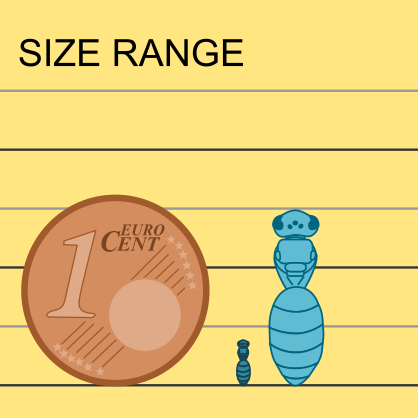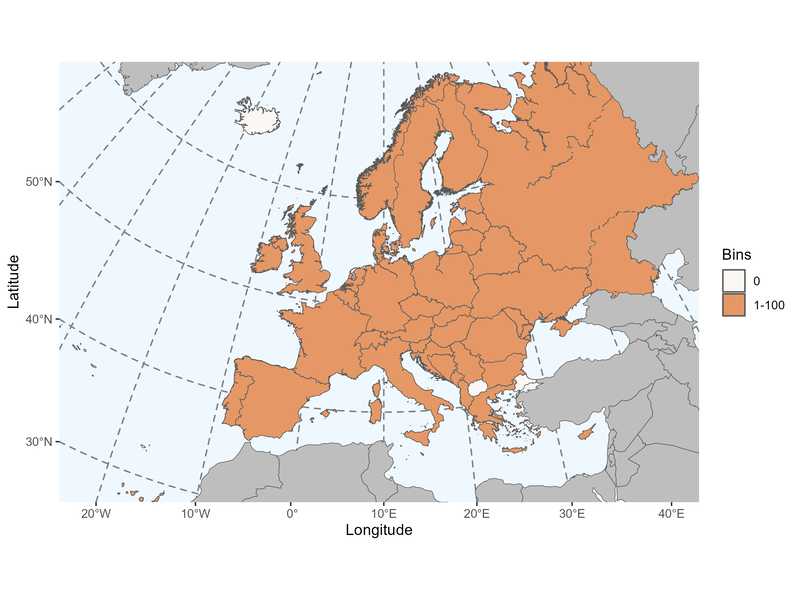Author: Latreille, 1804
|
Type species: Nomada gibba Fabricius, 1804 = Sphex gibba Linnaeus, 1758, monobasic.
Synonyms: Dichroa Illiger, 1806; Sabulicola Verhoeff, 1890; Thrausmus Buysson, 1900; Drepanium Robertson, 1903; Proteraner Robertson, 1903; Dialonia Robertson, 1903; Machaeris Robertson, 1903; Sphecodium Robertson, 1903; Stelidium Robertson, 1903; Sphegodes Mavromoustakis, 1949. |
Clade: Anthophila
Family: Halictidae Subfamily: Halictinae Tribe: Sphecodini |
|
Distinctive traits
|
Pictures of distinctive traits.
(Sorry, there is no picture available at this time. If you have some and would like to become a contributor to IDmyBee, please contact us.) |
Morphologically close genera and how to distinguish them
Lasioglossum species have submarginal vein 3 and recurrent vein 2 much less visible than submarginal vein 1.
Halictus males always have a band of yellow at the apex of the clypeus. Halictus females have a scopa on their legs.
Nomada species have long mouthparts (long-tongue morphology).
Andrena species have a basal vein straight or at most slightly curved.
- Sphecodes - Lasioglossum
Lasioglossum species have submarginal vein 3 and recurrent vein 2 much less visible than submarginal vein 1.
- Sphecodes - Halictus
Halictus males always have a band of yellow at the apex of the clypeus. Halictus females have a scopa on their legs.
- Sphecodes - Nomada
Nomada species have long mouthparts (long-tongue morphology).
- Sphecodes - Andrena
Andrena species have a basal vein straight or at most slightly curved.
General comments on Sphecodes species identification
Identification criteria include genitalia, mandible and posterior wings, which should be made visible as much as possible.
Identification criteria include genitalia, mandible and posterior wings, which should be made visible as much as possible.
Sorry, but the species identification tool is not yet available for Sphecodes.
Please check the reference(s) below for traditional keys.
Please check the reference(s) below for traditional keys.
|
List of the 48 Sphecodes species found in Europe
(Ghisbain et al. 2023): Sphecodes aetnensis Nobile, 1996 Sphecodes albilabris (Fabricius, 1793) Sphecodes algeriensis Alfken, 1914 Sphecodes alternatus Smith, 1853 Sphecodes anatolicus Warncke, 1992 Sphecodes atlanticus Warncke, 1992 Sphecodes barbatus Blüthgen, 1923 Sphecodes combai Nobile & Turrisi, 2004 Sphecodes crassanus Warncke, 1992 Sphecodes crassus Thomson, 1870 Sphecodes creticus Warncke, 1992 Sphecodes cristatus Hagens, 1882 Sphecodes croaticus Meyer, 1921 Sphecodes cypricus Blüthgen, 1938 Sphecodes dusmeti Blüthgen, 1924 Sphecodes ephippius (Linnaeus, 1767) Sphecodes ferruginatus Hagens, 1882 Sphecodes geoffrellus (Kirby, 1802) Sphecodes gibbus (Linnaeus, 1758) Sphecodes gomerensis Warncke, 1992 Sphecodes hirtellus Blüthgen, 1923 Sphecodes hyalinatus Hagens, 1882 Sphecodes intermedius Blüthgen, 1923 Sphecodes larochei Warncke, 1992 Sphecodes longuloides Blüthgen, 1923 Sphecodes longulus Hagens, 1882 |
Sphecodes majalis Pérez, 1903 Sphecodes marginatus Hagens, 1882 Sphecodes miniatus Hagens, 1882 Sphecodes monilicornis (Kirby, 1802) Sphecodes niger Hagens, 1874 Sphecodes nomioidis Pesenko, 1979 Sphecodes olivieri Lepeletier, 1825 Sphecodes pellucidus Smith, 1845 Sphecodes piceohirtus Blüthgen, 1858 Sphecodes pinguiculus Pérez, 1903 Sphecodes pseudocrassus Blüthgen, 1924 Sphecodes pseudofasciatus Blüthgen, 1925 Sphecodes puncticeps Thomson, 1870 Sphecodes reticulatus Thomson, 1870 Sphecodes rubicundus Hagens, 1875 Sphecodes rubripes Spinola, 1838 Sphecodes ruficrus (Erichson, 1835) Sphecodes rufiventris (Panzer, 1798) Sphecodes scabricollis Wesmael, 1835 Sphecodes schenckii Hagens, 1882 Sphecodes spinulosus Hagens, 1875 Sphecodes zangherii Noskiewicz, 1931 |
References with identification keys for some of the species:
- Amiet F., Müller A. & Neumeyer R.,1999. Apidae 2: Colletes, Dufourea, Hylaeus, Nomia, Nomioides, Rhophitoides, Rophites, Sphecodes, Systropha (Fauna Helvetica 4). Centre suisse de cartographie de la faune (CSCF), Neuchâtel, 239 pp.
- Pesenko, Y.A., Banaszak, J., Radchenko, V.G. & Cierzniak, T. 2000. Bees of the family Halictidae (excluding Sphecodes) of Poland. Bydgoszcz. 348pp.
- Bogush P. & Straka J. 2012. Review and identification of the cuckoo bees of central Europe (Hymenoptera: Halictidae: Sphecodes). Zootaxa 3311: 1–41.
- Falk S.J. (2015) Field Guide to the Bees of Great Britain and Ireland. Bloomsbury wildlife guides. 432 p.
Online resources:
Atlas hymenoptera (World, Europe & Belgium)
BWARS (UK)
Discover Life (World)
WestPalBees (West Palearctic)
Atlas hymenoptera (World, Europe & Belgium)
BWARS (UK)
Discover Life (World)
WestPalBees (West Palearctic)
Page contributors:
You noticed a mistake? You have a suggestion to improve this page?
Don't keep it to yourself, contact us and become a contributor to IDmyBee!
- Adrien Perrard (Dec. 2023)
- Adrien Perrard (Dec. 2019)
You noticed a mistake? You have a suggestion to improve this page?
Don't keep it to yourself, contact us and become a contributor to IDmyBee!
References used to write this page:
- Ghisbain, G., Rosa, P., Bogusch, P., Flaminio, S., Le Divelec, R., Dorchin, A., Kasparek, M., Kuhlmann, M., Litman, J., Mignot, M., Müller, A., Praz, C., Radchenko, V.G., Rasmont, P., Risch, S., Roberts, S.P.M., Smit, J., Wood, T.J., Michez, D. & Reverte, S. (2023). The new annotated checklist of the wild bees of Europe (Hymenoptera: Anthophila). Zootaxa, 5327(1), 1-147.
- Michener, C.D. 2007. The Bees of the World, 2nd Edition. The John Hopkins University Press, Baltimore.
- Michez D., Rasmont P., Terzo, M., Vereecken, N. 2019. Abeilles d'Europes. Hymenoptères d'Europes, Volume 1. N.A.P. Editions.
- Nieto, A., Roberts, S. P., Kemp, J., Rasmont, P., Kuhlmann, M., García Criado, M., ... & Michez, D. 2014. European red list of bees. Luxembourg: Publication Office of the European Union, 98.
- Rasmont, P., Devalez, Jelle, Pauly, A., Michez, D. & Radchenko, V.G. 2017. Addition to the checklist of IUCN European wild bees (Hymenoptera: Apoidea). Annales de la Société entomologique de France 53: 17-32.



